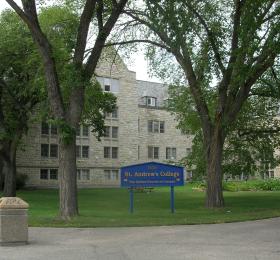St. Andrew's College
- Regular
Description of the Historic Place
St. Andrew’s College is located on the University of Saskatchewan campus in Saskatoon at 1121 College Drive. The building was constructed in 1922 in the Collegiate Gothic style.
Heritage Value
The heritage value of St. Andrews College resides in its association with theological education in Saskatoon. Originally founded in 1912, St. Andrews College (previously named the Presbyterian Theological College in Saskatoon) was proclaimed by an Act of the Saskatchewan Legislature in 1913. The College was originally located in a large family home on Albert Avenue before the University of Saskatchewan agreed to lease 4.5 acres of land to the College for a period of 21 years beginning in 1914. The lease was subject to renewal, but was conditional: the land could only be used “for the purpose of erecting buildings and structures for the advancement of learning and for teaching and instruction in Theology and Divinity.” Foundations were laid and material accumulated, but all plans were cancelled with the outbreak of the First World War.
Designed by architect David Brown, construction did not begin again on the College until 1922 on land at the southwest corner of the campus, adjacent to the main campus entrance. The building held its first classes in the fall of 1923. As with many communities and congregations across the Prairies, St. Andrew's College struggled to support students and maintain the educational program throughout the years of market collapse, depression and drought of the 1930s. The 1930s closed with Canada at war again and with many St. Andrew College students serving with the Canadian Armed Forces in Europe. Notable graduates of St. Andrews College include Lydia Gruchy, the first woman to be ordained in the United Church of Canada; and Lorne Calvert, former Premier of Saskatchewan.
During the 1950s plans were drafted for the completion of the East Wing of St. Andrew's College. The expansion was a signal to the wider church about the permanence and future of the college at a time when the need for a theological presence on the Prairies was being debated. The addition was completed in 1961 by the architectural firm of Webster, Forrester, and Scott.
The heritage value of St. Andrews College also lies in the building's Collegiate Gothic architecture, a style symbolic of older, well-established universities. Its architectural style is evident in its vertical lines and strong symmetrical massing, Gothic fenestration, and decorative motifs. St. Andrew’s College remains as an important architectural feature on the University of Saskatchewan Campus and along College Drive.
Source: City of Saskatoon Built Heritage Database
Character Defining Elements
Key elements which contribute to the heritage value of this historic resource include:
- Those features that speak to its setting, such its location within the University of Saskatchewan and along College Drive;
- Its imposing and elaborate appearance representative in its form, massing and scale; and
- Its Collegiate Gothic style of architecture, evident in: its vertical lines and strong symmetrical massing, Gothic fenestration and decorative motifs, and fieldstone walls.

